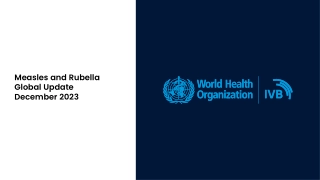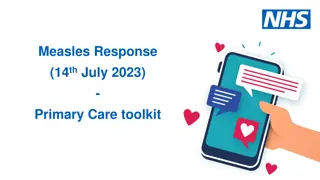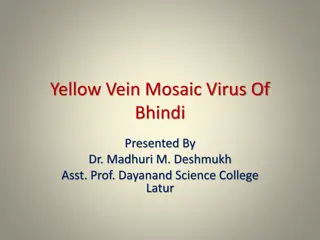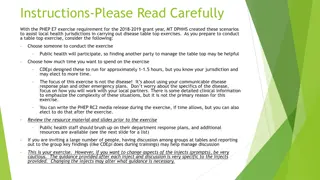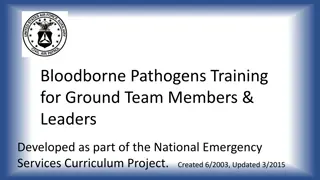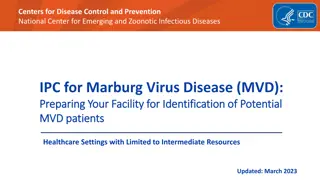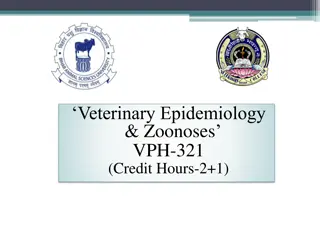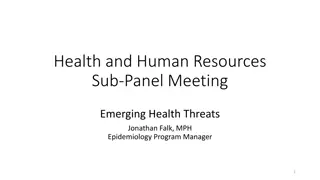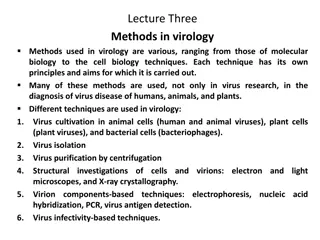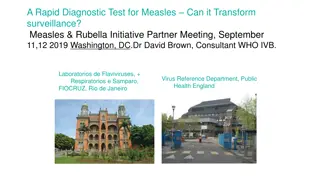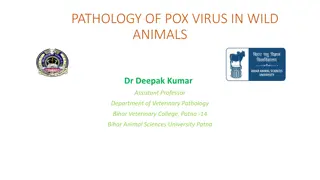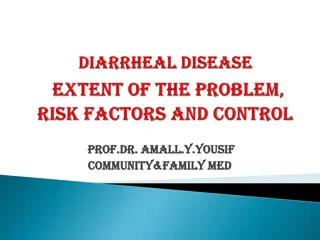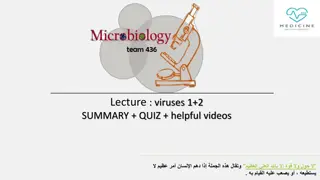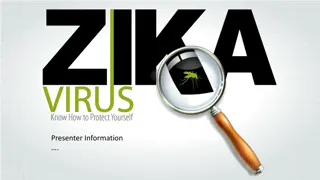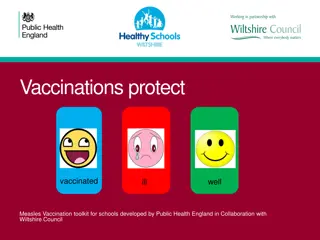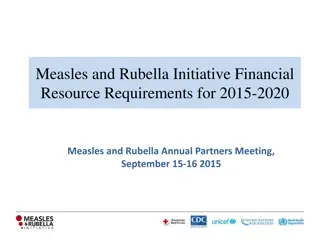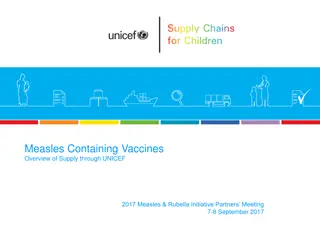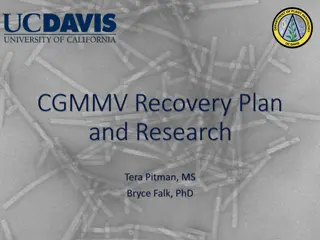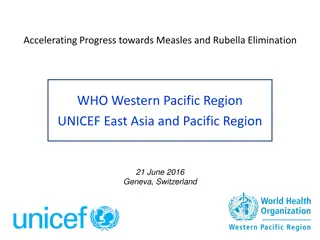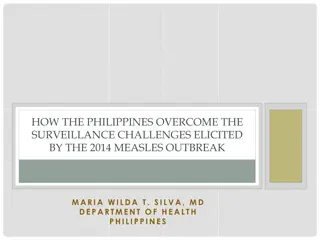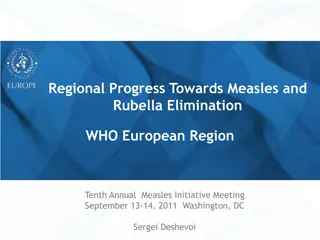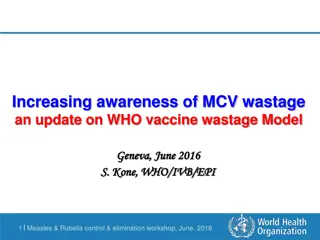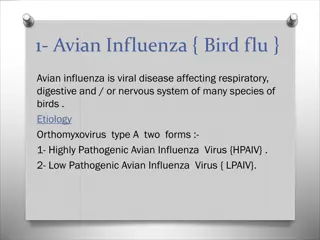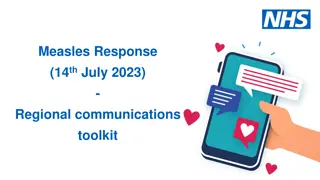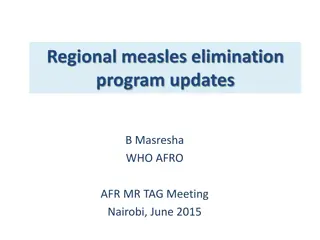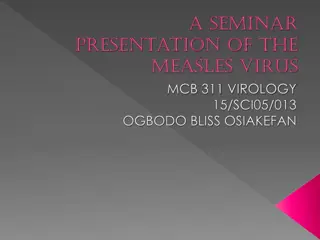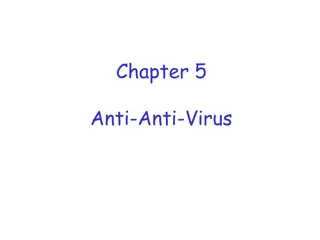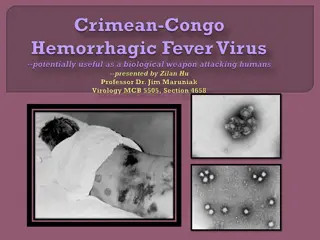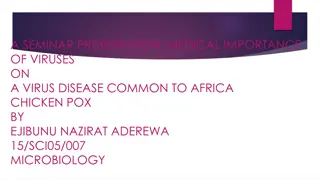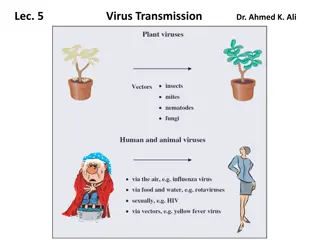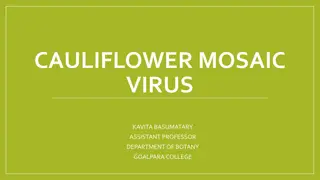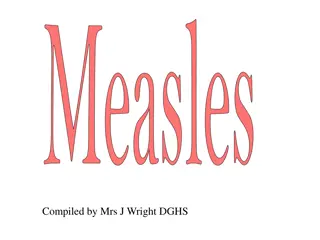Measles and Rubella Global Update December 2023
Stay informed with the latest data on measles and rubella cases worldwide with this report. Surveillance data, epidemiologic data, and laboratory reports are analyzed and updated monthly. For accurate and up-to-date information on the global status of measles and rubella, access this report. To rece
8 views • 63 slides
Clinical Algorithm for Rash Evaluation
The clinical algorithm outlines the evaluation process for a patient presenting with a rash, focusing on the assessment for measles transmission. It covers key criteria, testing recommendations, and guidelines for suspected measles cases. Healthcare providers can utilize this algorithm to determine
0 views • 5 slides
Urgent Measles Awareness Campaign in Response to Rising Cases in England
Measles cases are on the rise in England, with a significant number reported in London. The vaccination rate is below the target set by WHO, posing a high risk of outbreaks. The campaign aims to increase awareness about the seriousness of measles, educate the public on the benefits of the MMR vaccin
0 views • 14 slides
Global Measles and Rubella Update - April 2024
The Global Measles and Rubella Report provides provisional data on the reported cases of measles and rubella, distributed monthly via email. Official numbers are available in July each year through the WHO/UNICEF annual data collection. The report is based on surveillance data from Member States, wi
7 views • 62 slides
Create a Virus Using Notepad: Dangerous Notepad Virus Codes
Learn how to create a virus using Notepad by following various dangerous virus codes such as creating fake Windows errors, stopping someone's internet access, and crashing a PC forever. Be cautious with these codes as they can cause serious harm to a computer system.
0 views • 10 slides
Understanding Yellow Vein Mosaic Virus of Bhindi
Yellow Vein Mosaic Virus of Bhindi, also known as Okra Yellow Vein Mosaic, is a viral disease caused by the Begomovirus, affecting okra plants. The disease manifests through symptoms like vein-clearing and vein-chlorosis of leaves, leading to yellow network patterns on the leaves and stunted, malfor
0 views • 14 slides
Public Health Emergency Preparedness Exercise: Measles Response Scenario
MT DPHHS designed scenarios to help local health jurisdictions carry out disease table top exercises for the 2018-2019 grant year. The focus is on activating emergency response plans, engaging local partners, and identifying gaps in preparedness plans through a simulated measles outbreak situation i
0 views • 49 slides
Bloodborne Pathogens Training Overview for Ground Team Members
Understanding bloodborne pathogens is crucial for ground team members to protect themselves and others. This training covers what bloodborne pathogens are, focusing on Hepatitis B Virus (HBV) and Human Immunodeficiency Virus (HIV), their symptoms, transmission risks, and prevention methods. HBV fact
0 views • 29 slides
Importance of Screening and Separation in Marburg Virus Disease Control
Early identification and separation of suspected Marburg virus disease patients play a crucial role in preventing the spread of the disease within healthcare settings. Screening and setting up specific areas for identification and isolation are essential steps to protect healthcare workers, patients
1 views • 15 slides
Understanding Rabies: A Comprehensive Overview
Rabies is an acute fatal disease affecting humans and warm-blooded animals, characterized by abnormal behavior, nervous disturbances, excessive salivation, and respiratory paralysis. It claims around 55,000 human lives globally, with efforts in rabies control showing marginal success. The etiology o
0 views • 22 slides
Mẹ bị sốt virus ảnh hưởng gì cho thai nhi không
M\u1eb9 b\u1ea7u b\u1ecb s\u1ed1t virus c\u00f3 \u1ea3nh h\u01b0\u1edfng \u0111\u1ebfn thai nhi kh\u00f4ng? Mang thai l\u00e0 giai \u0111o\u1ea1n nh\u1ea1y c\u1ea3m v\u00e0 m\u1eb9 d\u1ec5 b\u1ecb nhi\u1ec5m virus, vi khu\u1ea9n g\u00e2y s\u1ed1t.
0 views • 3 slides
Emerging Health Threats: Ebola, Measles, and Acute Flaccid Myelitis Updates
The Democratic Republic of the Congo faced its 10th Ebola outbreak in 2018, with 608 reported cases. Measles cases in the U.S. surged between 2009-2014 due to lack of vaccination, while Acute Flaccid Myelitis causes muscle weakness. These health threats are significant and require attention to preve
3 views • 24 slides
Understanding OSHA Bloodborne Pathogens Training and Hepatitis B Virus
Covering the basics of OSHA Bloodborne Pathogens Standard, this training material provides essential information on bloodborne pathogens, including Hepatitis B Virus (HBV). It emphasizes the importance of training for individuals with occupational exposure, outlining crucial topics such as Hepatitis
2 views • 56 slides
Overview of Virology Methods: Cultivation, Isolation, Purification
Various methods are employed in virology, including virus cultivation in different cells, virus isolation, and virus purification through centrifugation. Structural investigations, virion component-based techniques, and virus infectivity-based techniques are also common in virology research. Underst
0 views • 15 slides
Role of Rapid Diagnostic Test for Measles in Global Surveillance
Laboratory-based surveillance is crucial for monitoring and controlling measles outbreaks. The development of new tools like rapid diagnostic tests (RDTs) for measles diagnosis can revolutionize surveillance efforts. Challenges in introducing new diagnostics are discussed, along with the importance
0 views • 30 slides
Pathology of Pox Virus in Wild Animals by Dr. Deepak Kumar
Pox viruses can affect wild animals, with Monkeypox emerging as a significant zoonotic virus in Central and West Africa. The disease shows similarities to smallpox but is less severe. Pox lesions are characteristic signs of infection, and outbreaks have been documented in regions with a history of s
0 views • 16 slides
Understanding Feco-Oral Diseases and Diarrhea Transmission
Feco-oral diseases, primarily transmitted through the fecal-oral route, remain a significant global health concern, especially affecting children under 5 and the elderly. Diarrhea, characterized by WHO as three or more watery stools in 24 hours, poses a substantial burden, with infectious agents cau
0 views • 46 slides
Viral Infections of the Respiratory System Lecture Summary & Quiz
This lecture covers viral infections of the respiratory system, focusing on Avian flu, Influenza Virus, Respiratory Syncytial Virus, Human metapneumovirus, Parainfluenza viruses, Measles, and Mumps virus. It includes information on the structure, symptoms, lab diagnosis, treatment, and prevention of
0 views • 11 slides
Understanding Zika Virus: Risks and Precautions
Zika virus is a mosquito-borne infection that can lead to birth defects and neurologic disorders. It spreads through mosquito bites and can also be transmitted from mother to child during pregnancy or through sexual contact. The virus is prevalent in South and Central America, the Caribbean, and is
0 views • 17 slides
Understanding Measles Vaccination and Herd Immunity: A Comprehensive Overview
Dive into the world of measles vaccination with this detailed presentation covering vaccine composition, symptoms, protection methods, and debunking myths. Learn how vaccinations not only safeguard individuals but also contribute to herd immunity, enhancing community health.
0 views • 19 slides
Understanding Akabane Disease: Causes, Symptoms, and Prevention
Akabane disease, also known as Enzootic Bovine Arthrogryposis and Hydranencephaly, is a viral illness transmitted by arthropods that primarily affects calves, lambs, and kids. The disease can lead to congenital abnormalities such as joint immobility and absence of the cerebral hemisphere. It is caus
2 views • 19 slides
Measles and Rubella Initiative Financial Resource Overview
The Measles and Rubella Initiative's Financial Resource Requirements for 2015-2020 were developed to support the Global Measles & Rubella Strategic Plan. The estimated budget is $2.6 billion for 2015-2020, focusing on controlling measles, rubella, and CRS in 77 countries. The costs are categorized i
0 views • 13 slides
Overview of Measles-Containing Vaccines Supply and Demand through UNICEF
The supply and demand dynamics of measles-containing vaccines (MCV) procured through UNICEF are explored, highlighting the total value of vaccines procured, the impact on humanitarian situations, and the challenges faced in forecasting and production. UNICEF works with multiple manufacturers for MCV
0 views • 7 slides
Understanding Cucumber Green Mottle Mosaic Virus: Disease Cycle and Testing Methods
This content provides detailed information on Cucumber Green Mottle Mosaic Virus, including its nucleotide genome, disease cycle, testing methods like DAS-ELISA and RT-PCR, seed testing protocols, bioassay for virus confirmation, and symptom expression in host plants. The data covers aspects such as
0 views • 14 slides
Progress Towards Measles and Rubella Elimination in the Western Pacific Region
WHO and UNICEF have set ambitious goals for eliminating measles and rubella, emphasizing the importance of routine immunization. Progress is tracked through reported cases, vaccine coverage, and supplementary immunization activities (SIAs) in various countries of the Western Pacific Region from 2000
0 views • 20 slides
Strategies for Overcoming Surveillance Challenges During the 2014 Measles Outbreak in the Philippines
The Philippines faced surveillance challenges during the 2014 measles outbreak, including manpower capacity, logistics, data management, and reporting mechanisms. Key interventions involved activating surge capacity, conducting orientations, procuring specimen kits, and promoting efficient data coll
0 views • 18 slides
Progress Towards Measles and Rubella Elimination in WHO European Region
The WHO European Region has been making significant progress towards eliminating measles and rubella, with 96% reduction in measles and 97% reduction in rubella from 1990 to 2011. Strategies include ensuring high vaccination coverage and conducting supplemental immunization activities in susceptible
0 views • 24 slides
Understanding the Impact of Vaccine Wastage on Measles Elimination Efforts
This presentation focuses on the significance of vaccine wastage in the context of measles elimination, emphasizing the factors influencing wastage, why it matters for achieving high vaccination coverage, and tools for estimating wastage. The content highlights the challenges posed by wastage on vac
0 views • 13 slides
Understanding Avian Influenza: Symptoms, Diagnosis, and Prevention
Avian influenza, or bird flu, is a viral disease affecting birds' respiratory, digestive, and nervous systems. It presents in two forms - Highly Pathogenic Avian Influenza Virus (HPAIV) and Low Pathogenic Avian Influenza Virus (LPAIV). The virus has two important surface antigens, Hemagglutinin (H)
0 views • 7 slides
Addressing the Measles Outbreak: UKHSA's Response and National Campaign Launch
Measles cases are rising in England, particularly in London, with a concerning low vaccination rate. UKHSA predicts high risk in London and nationwide, urging for intervention to prevent further spread. A national campaign focusing on MMR vaccine uptake is set to launch on 14th July, targeting low u
0 views • 10 slides
Overview of Bovine Viral Diarrhea Virus (BVDV)
Bovine Viral Diarrhea Virus (BVDV) is an RNA virus belonging to the Pestivirus genus in the Flaviviridae family. It is classified into BVDV-1 and BVDV-2 genotypes with distinct biotypes. BVDV is a significant infectious disease in the livestock industry worldwide, with high prevalence and clinical c
0 views • 14 slides
Progress Towards Measles Elimination in the African Region
The data presented showcases the progress and goals of measles elimination efforts in the African Region, focusing on targets for routine immunization coverage, introduction of MCV1 and MCV2 vaccines, supplementary immunization activities (SIAs), surveillance performance, and overall advancements to
0 views • 26 slides
Understanding Measles Virus: A Comprehensive Seminar Presentation
The measles virus, also known as rubeola or morbilli virus, is a highly contagious infection that primarily affects the respiratory system. This presentation delves into the classification, characteristics, and pathogenesis of the virus, shedding light on its structure, transmission, and impact on p
0 views • 24 slides
Understanding Anti-Anti-Virus Techniques and Retroviruses
Explore the world of anti-anti-virus techniques including Retroviruses and Entry Point Obfuscation. Learn about the methods used by viruses to evade detection and damage anti-virus software. Discover how Retroviruses like Ganda virus operate stealthily to hinder anti-virus programs. Delve into strat
0 views • 24 slides
Overview of Crimean-Congo Hemorrhagic Fever Virus
Crimean-Congo Hemorrhagic Fever (CCHF) virus is an RNA virus belonging to the genus Nairovirus, causing a zoonotic disease with high mortality rates in humans. The virus is transmitted mainly by ticks, particularly the Hyalomma species, and can result in severe illness in both domestic and wild anim
0 views • 17 slides
Understanding Chicken Pox: A Seminar on the Medical Importance of Viruses
Chicken pox, caused by the Varicella-zoster virus, is a contagious infection primarily affecting children. This seminar presentation delves into the classification, route of infection, symptoms, and treatment of this viral disease common in Africa. The Varicella-zoster virus, a member of the herpes
0 views • 17 slides
Understanding Virus Transmission via Vectors in Hosts
Viruses must be propagated and transmitted to new hosts for survival. They can be spread via vectors like arthropods, which acquire and transmit viruses during feeding. This transmission can occur quickly through the vector's mouthparts or more slowly via circulation in the vector's body. Plant viru
0 views • 14 slides
Understanding Cauliflower Mosaic Virus: Structure, Reproduction, and Genome
Cauliflower Mosaic Virus (CaMV) is a plant virus studied by Assistant Professor Kavita Basumatary at Goalpara College. The virus has a circular, double-stranded DNA genome of about 8000 bp in length with unique discontinuities. Reproduction involves the viral genome entering the host cell nucleus, w
0 views • 6 slides
Comprehensive Overview of Measles: Symptoms, Management, and Prevention
This compilation by Mrs. J. Wright from DGHS provides detailed information on measles, including initial symptoms such as red spots, fever, progression of the disease, pathology, data collection, and management and prevention strategies like vaccinations and education of parents. The effectiveness o
0 views • 17 slides
Understanding Nipah Virus: A Comprehensive Overview
Nipah virus, belonging to the Paramyxoviridae family, is a zoonotic virus with high pathogenicity and mortality rates. It falls under the Henipavirus genus, known for infecting a wide range of animal species. Its virion structure consists of non-segmented, negative-sense RNA, and the viral genome co
0 views • 22 slides
